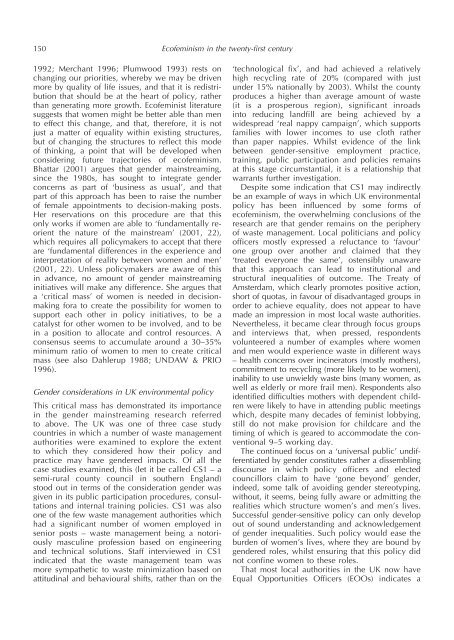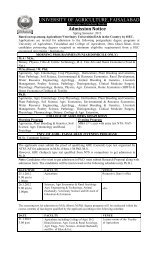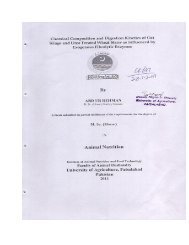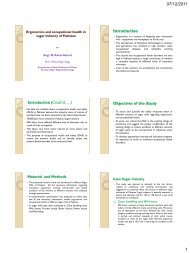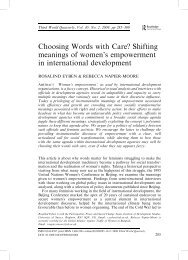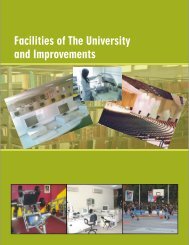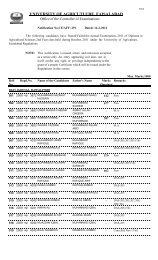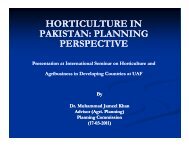Ecofeminism in the twenty-first century
Ecofeminism in the twenty-first century
Ecofeminism in the twenty-first century
- No tags were found...
Create successful ePaper yourself
Turn your PDF publications into a flip-book with our unique Google optimized e-Paper software.
150 <strong>Ecofem<strong>in</strong>ism</strong> <strong>in</strong> <strong>the</strong> <strong>twenty</strong>-<strong>first</strong> <strong>century</strong>1992; Merchant 1996; Plumwood 1993) rests onchang<strong>in</strong>g our priorities, whereby we may be drivenmore by quality of life issues, and that it is redistributionthat should be at <strong>the</strong> heart of policy, ra<strong>the</strong>rthan generat<strong>in</strong>g more growth. Ecofem<strong>in</strong>ist literaturesuggests that women might be better able than mento effect this change, and that, <strong>the</strong>refore, it is notjust a matter of equality with<strong>in</strong> exist<strong>in</strong>g structures,but of chang<strong>in</strong>g <strong>the</strong> structures to reflect this modeof th<strong>in</strong>k<strong>in</strong>g, a po<strong>in</strong>t that will be developed whenconsider<strong>in</strong>g future trajectories of ecofem<strong>in</strong>ism.Bhattar (2001) argues that gender ma<strong>in</strong>stream<strong>in</strong>g,s<strong>in</strong>ce <strong>the</strong> 1980s, has sought to <strong>in</strong>tegrate genderconcerns as part of ‘bus<strong>in</strong>ess as usual’, and thatpart of this approach has been to raise <strong>the</strong> numberof female appo<strong>in</strong>tments to decision-mak<strong>in</strong>g posts.Her reservations on this procedure are that thisonly works if women are able to ‘fundamentally reorient<strong>the</strong> nature of <strong>the</strong> ma<strong>in</strong>stream’ (2001, 22),which requires all policymakers to accept that <strong>the</strong>reare ‘fundamental differences <strong>in</strong> <strong>the</strong> experience and<strong>in</strong>terpretation of reality between women and men’(2001, 22). Unless policymakers are aware of this<strong>in</strong> advance, no amount of gender ma<strong>in</strong>stream<strong>in</strong>g<strong>in</strong>itiatives will make any difference. She argues thata ‘critical mass’ of women is needed <strong>in</strong> decisionmak<strong>in</strong>gfora to create <strong>the</strong> possibility for women tosupport each o<strong>the</strong>r <strong>in</strong> policy <strong>in</strong>itiatives, to be acatalyst for o<strong>the</strong>r women to be <strong>in</strong>volved, and to be<strong>in</strong> a position to allocate and control resources. Aconsensus seems to accumulate around a 30–35%m<strong>in</strong>imum ratio of women to men to create criticalmass (see also Dahlerup 1988; UNDAW & PRIO1996).Gender considerations <strong>in</strong> UK environmental policyThis critical mass has demonstrated its importance<strong>in</strong> <strong>the</strong> gender ma<strong>in</strong>stream<strong>in</strong>g research referredto above. The UK was one of three case studycountries <strong>in</strong> which a number of waste managementauthorities were exam<strong>in</strong>ed to explore <strong>the</strong> extentto which <strong>the</strong>y considered how <strong>the</strong>ir policy andpractice may have gendered impacts. Of all <strong>the</strong>case studies exam<strong>in</strong>ed, this (let it be called CS1 – asemi-rural county council <strong>in</strong> sou<strong>the</strong>rn England)stood out <strong>in</strong> terms of <strong>the</strong> consideration gender wasgiven <strong>in</strong> its public participation procedures, consultationsand <strong>in</strong>ternal tra<strong>in</strong><strong>in</strong>g policies. CS1 was alsoone of <strong>the</strong> few waste management authorities whichhad a significant number of women employed <strong>in</strong>senior posts – waste management be<strong>in</strong>g a notoriouslymascul<strong>in</strong>e profession based on eng<strong>in</strong>eer<strong>in</strong>gand technical solutions. Staff <strong>in</strong>terviewed <strong>in</strong> CS1<strong>in</strong>dicated that <strong>the</strong> waste management team wasmore sympa<strong>the</strong>tic to waste m<strong>in</strong>imization based onattitud<strong>in</strong>al and behavioural shifts, ra<strong>the</strong>r than on <strong>the</strong>‘technological fix’, and had achieved a relativelyhigh recycl<strong>in</strong>g rate of 20% (compared with justunder 15% nationally by 2003). Whilst <strong>the</strong> countyproduces a higher than average amount of waste(it is a prosperous region), significant <strong>in</strong>roads<strong>in</strong>to reduc<strong>in</strong>g landfill are be<strong>in</strong>g achieved by awidespread ‘real nappy campaign’, which supportsfamilies with lower <strong>in</strong>comes to use cloth ra<strong>the</strong>rthan paper nappies. Whilst evidence of <strong>the</strong> l<strong>in</strong>kbetween gender-sensitive employment practice,tra<strong>in</strong><strong>in</strong>g, public participation and policies rema<strong>in</strong>sat this stage circumstantial, it is a relationship thatwarrants fur<strong>the</strong>r <strong>in</strong>vestigation.Despite some <strong>in</strong>dication that CS1 may <strong>in</strong>directlybe an example of ways <strong>in</strong> which UK environmentalpolicy has been <strong>in</strong>fluenced by some forms ofecofem<strong>in</strong>ism, <strong>the</strong> overwhelm<strong>in</strong>g conclusions of <strong>the</strong>research are that gender rema<strong>in</strong>s on <strong>the</strong> peripheryof waste management. Local politicians and policyofficers mostly expressed a reluctance to ‘favour’one group over ano<strong>the</strong>r and claimed that <strong>the</strong>y‘treated everyone <strong>the</strong> same’, ostensibly unawarethat this approach can lead to <strong>in</strong>stitutional andstructural <strong>in</strong>equalities of outcome. The Treaty ofAmsterdam, which clearly promotes positive action,short of quotas, <strong>in</strong> favour of disadvantaged groups <strong>in</strong>order to achieve equality, does not appear to havemade an impression <strong>in</strong> most local waste authorities.Never<strong>the</strong>less, it became clear through focus groupsand <strong>in</strong>terviews that, when pressed, respondentsvolunteered a number of examples where womenand men would experience waste <strong>in</strong> different ways– health concerns over <strong>in</strong>c<strong>in</strong>erators (mostly mo<strong>the</strong>rs),commitment to recycl<strong>in</strong>g (more likely to be women),<strong>in</strong>ability to use unwieldy waste b<strong>in</strong>s (many women, aswell as elderly or more frail men). Respondents alsoidentified difficulties mo<strong>the</strong>rs with dependent childrenwere likely to have <strong>in</strong> attend<strong>in</strong>g public meet<strong>in</strong>gswhich, despite many decades of fem<strong>in</strong>ist lobby<strong>in</strong>g,still do not make provision for childcare and <strong>the</strong>tim<strong>in</strong>g of which is geared to accommodate <strong>the</strong> conventional9–5 work<strong>in</strong>g day.The cont<strong>in</strong>ued focus on a ‘universal public’ undifferentiatedby gender constitutes ra<strong>the</strong>r a dissembl<strong>in</strong>gdiscourse <strong>in</strong> which policy officers and electedcouncillors claim to have ‘gone beyond’ gender,<strong>in</strong>deed, some talk of avoid<strong>in</strong>g gender stereotyp<strong>in</strong>g,without, it seems, be<strong>in</strong>g fully aware or admitt<strong>in</strong>g <strong>the</strong>realities which structure women’s and men’s lives.Successful gender-sensitive policy can only developout of sound understand<strong>in</strong>g and acknowledgementof gender <strong>in</strong>equalities. Such policy would ease <strong>the</strong>burden of women’s lives, where <strong>the</strong>y are bound bygendered roles, whilst ensur<strong>in</strong>g that this policy didnot conf<strong>in</strong>e women to <strong>the</strong>se roles.That most local authorities <strong>in</strong> <strong>the</strong> UK now haveEqual Opportunities Officers (EOOs) <strong>in</strong>dicates a


